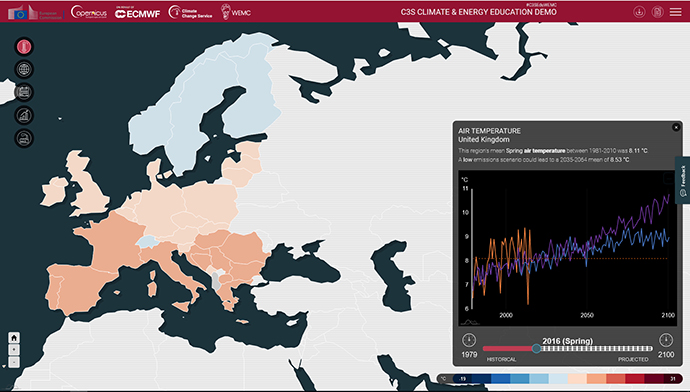Private- and public-sector users of the EU-funded Copernicus Climate Change Service (C3S) implemented by ECMWF are building a growing range of sector-specific applications. The applications are part of the Sectoral Information System (SIS) of C3S. The idea behind the SIS is to promote the creation of downstream applications for climate adaptation and mitigation. Based on the data and tools provided by C3S, intermediate users showcase the potential of climate data for sector-specific applications to the benefit of end users.
A growing portfolio
Building upon the experience of the initial proof-of-concept phase, the SIS has expanded its activities towards new sectors. Today the SIS portfolio includes activities within the sectors of water management, energy, agriculture and forestry, tourism, health, infrastructure, insurance, transport, disaster risk reduction, coastal regions, and biodiversity. While the C3S Climate Data Store (CDS) infrastructure was initially unavailable to SIS contractors, the outputs created within the framework of the SIS have now started to be moved to the CDS or are directly developed there.

Datasets that combine climate information with sector-specific parameters have resulted in the creation of sector-specific climate impact indicators and associated tools. This is to the benefit of all C3S users, who can gain insights into how climate change may affect specific sectors. For example, with the development of a global biodiversity prototype service, led by the Flemish Institute for Technological Research (VITO), the SIS has started to demonstrate the potential for using climate information to improve biodiversity and ecosystem management. While biodiversity is and will continue to be affected by a changing climate, knowledge about the current climate together with an assessment of how it is changing is key for adaptation actions that aim to reduce biodiversity loss and associated consequences for society.
With the development of a platform that combines datasets, indicators and tools on biodiversity and ecosystem services, the SIS aims to fill a knowledge gap for improved decision-making by nature conservation agencies, policy- makers, scientists, and private companies. Complementary SIS activities include conducting a market analysis and showcasing the benefits of the tools to various end users working on biodiversity of fauna and flora on land and in the ocean. This knowledge will be directly relevant to practical decision-making, for example relating to the management of semi-natural grassland in the European Commission’s Biodiversity Strategy beyond 2020. In general, sector-specific information is important not only for evidence- based policymaking but also for the implementation and evaluation of associated measures.
Along with some datasets, the first software applications have been created within the framework of the SIS. As another example of how such tools can increase the uptake of data provided by C3S, applications such as the C3S Climate & Energy educational tool (C3S Edu Demo) allow students and teachers to explore climate and energy information using an interactive map. More information is available online: https://climate.copernicus.eu/bringing-climate-data-classroom.
Outlook
Users have given overall positive feedback on the SIS, but some challenges remain with respect to functionalities and integrating SIS outputs into the CDS. Stakeholder engagement has been crucial in identifying these challenges and deciding how to improve the service where needed. User requirements, outputs, and the publication of data and tools are key parts of each SIS contract. While changes may be required to improve the migration of SIS outcomes into the CDS infrastructure, it is clear that the SIS is playing an important and growing role in the delivery of the Copernicus Climate Change Service by demonstrating how high-quality data can contribute to building a climate-resilient society.
